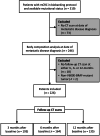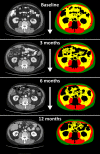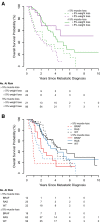Muscle Loss Is Associated with Overall Survival in Patients with Metastatic Colorectal Cancer Independent of Tumor Mutational Status and Weight Loss
- PMID: 33818860
- PMCID: PMC8176987
- DOI: 10.1002/onco.13774
Muscle Loss Is Associated with Overall Survival in Patients with Metastatic Colorectal Cancer Independent of Tumor Mutational Status and Weight Loss
Abstract
Background: Survival in patients with metastatic colorectal cancer (mCRC) has been associated with tumor mutational status, muscle loss, and weight loss. We sought to explore the combined effects of these variables on overall survival.
Materials and methods: We performed an observational cohort study, prospectively enrolling patients receiving chemotherapy for mCRC. We retrospectively assessed changes in muscle (using computed tomography) and weight, each dichotomized as >5% or ≤5% loss, at 3, 6, and 12 months after diagnosis of mCRC. We used regression models to assess relationships between tumor mutational status, muscle loss, weight loss, and overall survival. Additionally, we evaluated associations between muscle loss, weight loss, and tumor mutational status.
Results: We included 226 patients (mean age 59 ± 13 years, 53% male). Tumor mutational status included 44% wild type, 42% RAS-mutant, and 14% BRAF-mutant. Patients with >5% muscle loss at 3 and 12 months experienced worse survival controlling for mutational status and weight (3 months hazard ratio, 2.66; p < .001; 12 months hazard ratio, 2.10; p = .031). We found an association of >5% muscle loss with BRAF-mutational status at 6 and 12 months. Weight loss was not associated with survival nor mutational status.
Conclusion: Increased muscle loss at 3 and 12 months may identify patients with mCRC at risk for decreased overall survival, independent of tumor mutational status. Specifically, >5% muscle loss identifies patients within each category of tumor mutational status with decreased overall survival in our sample. Our findings suggest that quantifying muscle loss on serial computed tomography scans may refine survival estimates in patients with mCRC.
Implications for practice: In this study of 226 patients with metastatic colorectal cancer, it was found that losing >5% skeletal muscle at 3 and 12 months after the diagnosis of metastatic disease was associated with worse overall survival, independent of tumor mutational status and weight loss. Interestingly, results did not show a significant association between weight loss and overall survival. These findings suggest that muscle quantification on serial computed tomography may refine survival estimates in patients with metastatic colorectal cancer beyond mutational status.
Keywords: Body composition; Colorectal cancer; Outcomes; Sarcopenia; Skeletal muscle; Survival.
© 2021 The Authors. The Oncologist published by Wiley Periodicals LLC on behalf of AlphaMed Press.
Conflict of interest statement
Figures



References
-
- Bray F, Ferlay J, Soerjomataram I et al. Global cancer statistics 2018: GLOBOCAN estimates of incidence and mortality worldwide for 36 cancers in 185 countries. CA Cancer J Clin 2018;68:394–424. - PubMed
-
- Horner MJ, Ries LAG, Krapcho M et al. SEER Cancer Statistics Review, 1975‐2006. Edwards BK Betheseda, MD: National Cancer Institute; 2009. https://seer.cancer.gov/csr/1975_2006/.
-
- Di Nicolantonio F, Martini M, Molinari F et al. Wild‐type BRAF is required for response to panitumumab or cetuximab in metastatic colorectal cancer. J Clin Oncol 2008;26:5705–5712. - PubMed
-
- Siena S, Rivera F, Taieb J et al. Survival outcomes in patients With RAS wild type metastatic colorectal cancer classified according to Köhne prognostic category and BRAF mutation status. Clin Colorectal Cancer 2018;17:50–57. - PubMed
-
- Lievre A, Bachet JB, Le Corre D et al. KRAS mutation status is predictive of response to cetuximab therapy in colorectal cancer. Cancer Res 2006;66:3992–3995. - PubMed
Publication types
MeSH terms
Substances
LinkOut - more resources
Full Text Sources
Other Literature Sources
Medical
Research Materials

